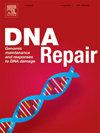校对Polδ和Polε的核酸外切酶活性对链终止核苷类似物的去除有不同的作用
IF 2.7
3区 生物学
Q2 GENETICS & HEREDITY
引用次数: 0
摘要
链终止核苷类似物(ctna)在复制过程中被复制聚合酶delta (Polδ)和epsilon (Polε)整合到基因组中,并通过阻止随后的聚合抑制DNA合成。Polε的校对外切酶活性去除合并的CTNAs,从而有助于细胞对这些药物的耐受性。然而,Polδ对校对外切酶活性的贡献尚未明确,Polδ与Polε之间的关系也尚未得到很好的理解。我们在这里表明,Polδ的外切酶活性有助于细胞对CTNAs的耐受性,而Polδ和Polε外切酶的作用取决于CTNAs的种类。我们测试了POLD1exo−/+细胞对CTNA Ara-C的敏感性,发现外切酶缺陷Polδ的表达使细胞对Ara-C敏感。此外,在Polε外切酶精通和Polε外切酶缺乏的细胞中,同样程度地降低了细胞对Ara-C的生存能力,表明这两种聚合酶独立地促进了细胞对Ara-C的耐受。相比之下,野生型、POLD1exo−/+和POLE1exo−/−细胞对ddC、AZT和阿洛夫定的敏感性相似,而POLD1exo−/+/POLE1exo−/−细胞的敏感性明显高于这些细胞,表明Polδ和Polε相互补偿。最后,我们发现复制聚合酶的外切酶活性不能去除新生DNA末端的ACV。综上所述,我们的研究结果表明,CTNAs对复制叉有不同的影响,并且对复制聚合酶的外切酶活性的要求取决于CTNAs的种类。本文章由计算机程序翻译,如有差异,请以英文原文为准。
Proofreading exonuclease activities of Polδ and Polε differentially contribute to the removal of chain-terminating nucleoside analogs
Chain-terminating nucleoside analogs (CTNAs) are incorporated into genome during replication by replicative polymerase delta (Polδ) and epsilon (Polε), then inhibit DNA synthesis by preventing subsequent polymerization. The proofreading exonuclease activity of Polε removes the incorporated CTNAs, thereby contributing to cellular tolerance to these drugs. However, the contribution of Polδ’s proofreading exonuclease activity has not been clarified, nor has the relationship between Polδ and Polε been well understood. We here show that Polδ’s exonuclease activity contributes to the cellular tolerance to CTNAs, with the role of Polδ and Polε exonucleases differing depending on the kinds of CTNAs. We tested the sensitivity of POLD1exo−/+ cells to a CTNA, Ara-C, and found that expression of the exonuclease deficient Polδ sensitizes cells to Ara-C. Furthermore, the exonuclease deficient Polδ reduced cell viability upon Ara-C to the same extent in both Polε exonuclease-proficient and -deficient cells, indicating that these two polymerases independently contribute to cellular tolerance to Ara-C. In contrast, wild-type, POLD1exo−/+, and POLE1exo−/− cells exhibited similar sensitivity to ddC, AZT, and alovudine, whilst POLD1exo−/+/POLE1exo−/− cells were considerably more sensitive compared with these cells, indicating that Polδ and Polε compensate for each other. Finally, we found that exonuclease activities of replicative polymerases cannot remove ACV from the end of nascent DNA. Taken together, our findings show that CTNAs have a differential impact on the replication fork, and the requirement of the exonuclease activities of replicative polymerases varies depending on the kinds of CTNAs.
求助全文
通过发布文献求助,成功后即可免费获取论文全文。
去求助
来源期刊

DNA Repair
生物-毒理学
CiteScore
7.60
自引率
5.30%
发文量
91
审稿时长
59 days
期刊介绍:
DNA Repair provides a forum for the comprehensive coverage of DNA repair and cellular responses to DNA damage. The journal publishes original observations on genetic, cellular, biochemical, structural and molecular aspects of DNA repair, mutagenesis, cell cycle regulation, apoptosis and other biological responses in cells exposed to genomic insult, as well as their relationship to human disease.
DNA Repair publishes full-length research articles, brief reports on research, and reviews. The journal welcomes articles describing databases, methods and new technologies supporting research on DNA repair and responses to DNA damage. Letters to the Editor, hot topics and classics in DNA repair, historical reflections, book reviews and meeting reports also will be considered for publication.
 求助内容:
求助内容: 应助结果提醒方式:
应助结果提醒方式:


